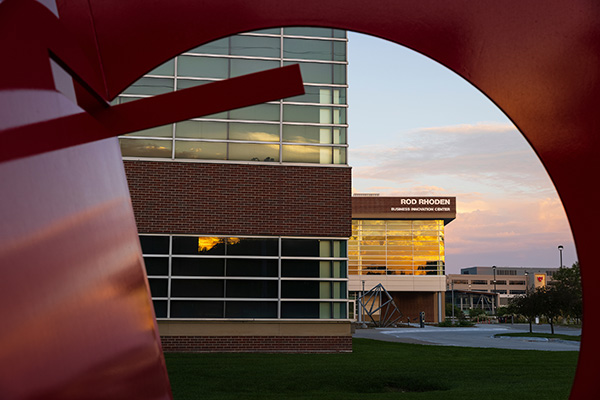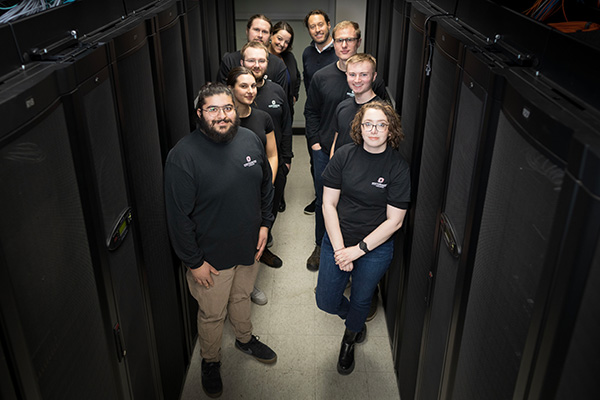up next Joel Elson and Erin Kearns
Preventing Violent Acts Through Chatbots
By Jackie Ostrowicki
March 2023
A stranger loitering in your neighborhood. A vehicle cruising the streets repeatedly. People arriving or leaving from homes at unusual hours.
You feel things are a little off, but you’re not sure why—or even what to do about it. Should you call the police? Nothing is overtly wrong. You’re not sure if what you’re seeing is suspicious activity.
But you don’t want to be labeled as an interfering neighbor. It doesn’t seem like it’s any of your business. You’re certain somebody else has already reported it.
Suspicious behavior or activity can be any action that is out of place and doesn’t fit into the usual day-to-day activity of your community. Too often, people are confused about what they should report and why. But by reporting suspicious situations or activity, you aid the police and make your community a safer place to live. You can reduce violence, minimize victimization, and improve overall quality of life.
So why don’t more people report the things they see?
“Technology can exponentially multiply what a single individual can do. This could increase the opportunities for issue prevention by making reporting easier and more scalable.”
The Department of Homeland Security believes that public safety is everyone’s responsibility. They run a program called “If You See Something, Say Something” that helps people recognize behaviors that may indicate a potential link to terrorism—and understand how to report suspicious activity to appropriate law enforcement or local authorities. Prompt, detailed reporting of suspicious activities can help prevent violent crimes or terrorist attacks.
How do people report this type of behavior or situations? Many states have designated a tip line to collect reports of suspicious activity. Others have online forms that can be filled out. And a team of researchers at the University of Nebraska at Omaha are working on a chatbot that walks users through identifying and reporting suspicious activity—which they hope will improve the quality and quantity of reporting.
Dr. Joel Elson, an assistant professor of IT innovation, has teamed up with Dr. Erin Kearns, a criminologist, on the project. Their complementary research strengths create a unique perspective on suspicious activity—one that brings together technology, criminology and psychology to address—and potentially remove—the barriers to reporting.
"It's a true team effort," Kearns said. "Dr. Elson studies human-computer trust, I study law enforcement and community trust. Without both areas of expertise, you couldn't develop this chatbot."

The research is funded under a $715,000 federal grant. Grants like these build on state support—which pays faculty and keeps buildings open and lights on—and allow researchers to pursue innovative approaches to pressing problems.
Building Technology People Can Trust
The National Counterterrorism Innovation, Technology and Education Center (NCITE) is the Department of Homeland Security's Center of Excellence for terrorism prevention and counterterrorism research. It is located in Mammel Hall at the University of Nebraska at Omaha. Elson and Kearns are both NCITE senior leaders and researchers.
This two-phase project is one of 37 prevention-focused research projects that DHS selected in 2021 for awards totaling $20 million through its competitive Targeted Violence and Terrorism Prevention Grant Program.
In the first phase, Kearns and Elson conducted a national survey, a local study and focus groups to learn about barriers to tips reporting and processing. They also developed a chatbot prototype. They have started the second phase, which involves refining and testing the chatbot.
The chatbot will be embedded in existing reporting platforms as an alternative to filling out a static web form. The information it receives is fed into existing networks. The goal: to elicit more complete information from people through dynamic ways of communication, using a conversation back and forth to prompt better responses.
"It's a true team effort. Dr. Elson studies human-computer trust, I study law enforcement and community trust. Without both areas of expertise, you couldn't develop this chatbot."
Technology gives the research potential broad national application.
“Technology is able to exponentially multiply what a single individual can do,” Elson said. “This could increase the opportunities for issue prevention by making reporting easier and more scalable.”
The two researchers are working with Sarpy County on the project.
“The whole goal of this is preventing a Columbine, a Parkland, a Virginia Tech,” Sarpy County Sheriff Captain Kevin Griger said, referring to past mass shootings. “This grant matters because it will help us better understand why and how people are giving tips—and why they are not giving tips. Those tips will help us better prevent acts of targeted violence.”
Researchers know there are gaps in reporting. People might not know what behavior merits reporting, how or where to report it and can show reluctance in elevating to law enforcement. A drop in community trust in public institutions contributes to this reluctance.
Improving tips reporting processes can build trust and strengthen community resilience to violence.

“We hope our work will contribute to building trust and support efforts to protect innocent lives,” Elson said.
Working Across Disciplines
Elson’s background connects psychology and technology. He received his undergraduate degree from Creighton in psychology, his master’s degree from UNO in management information systems and his Ph.D. from UNO in information technology. One of his research interests is how human experience and technology can be improved and furthered.
He was drawn at a young age to computers and tech systems. In middle school, Elson participated in a competition to improve community wellness, where he proposed a computing system to be used on recreational paths—a foreshadowing of the smart watches people would eventually wear to track calories, distance and heartrate.
“I’ve always thought technology has a tremendous potential to enhance our lives—whether that’s in health, improvements to our community or the ability to get work done,” Elson said.
Born and raised in Nebraska, Elson believes that the work being done at UNO is unique:
“You can accomplish things in Nebraska that can't be achieved anywhere else in the country. It's because Nebraskans come together and get things done—we support one another.”
“The whole goal of this is preventing a Columbine, a Parkland, a Virginia Tech. The NCITE project will help us better understand why and how people are giving tips—and why they are not giving tips.”
Kearns received her undergraduate degree in political science and psychology from Miami University, her master’s degree in forensic psychology from the City University of New York, and her Ph.D. in criminology and public policy from American University.
She was a freshman in college on 9/11 and worked as a teaching assistant for her Ph.D. mentor in an undergraduate class he taught on terrorism. That’s when it all clicked for her: both criminology and terrorism address law making, law breaking and responses to law breaking—a thread she has explored through her research.
Her research expertise includes the relationships between law enforcement and communities, public perceptions of law enforcement and how to improve those perceptions. Kearns also studies media representations of terrorism in news and entertainment, such as the popular Fox television show “24”—and how those representations influence public perceptions of terrorism.
Kearns work on public perception translates well to studying people’s willingness to report on suspicious activity.

“There’s myriad factors in why people do or don’t report,” Kearns said. “People ask themselves: is this really something I should report? Do I trust the authorities enough to talk to them? Do I want to get involved? Will I be wasting someone’s time if this turns out to be nothing?”
Preventing Terrorism—from the Heart of the Nation
The chatbot grant is the first prevention award won by NCITE researchers from the College of IS&T and the College of Public Affairs and Community Service. NCITE was created in 2020 when UNO received its largest federal grant ever—$36.5 million over 10 years for counterterrorism studies—from the Department of Homeland Security.
UNO was chosen to house NCITE following a highly competitive selection process that involved a site visit to Omaha by a team of DHS officials. UNO’s selection among dozens of universities submitting letters of interest reflected a long record of leadership across the university in national security and defense.
“NCITE not only has a unique mission, but a unique location,” Kearns said. “Being located here in Nebraska, in the middle of the country, we have the ability to think about and address counterterrorism issues in a much more grounded—and on the ground—way.”
Although the academic research hub is based at UNO, its reach stretches beyond Nebraska. Led by Dr. Gina Ligon, the center’s director, more than 60 academics from 26 universities work in counterterrorism research—innovating, educating and creating new prevention strategies.
“NCITE provides a vehicle for us to use our professional training and personal experiences to help fight violent groups who have already formed—and help prevent individuals from ever joining one in the first place,” Ligon said.

Ligon’s vision is to build a robust, relevant academic research hub that offers insight to help the national security workers in the field prevent terrorist attacks.
“Terrorism is a complex problem that calls for many different talents, energies, and resources,” Ligon said. “NCITE allows for focused collaboration across our institutions, leading to a comprehensive approach.”
An approach like the one taken by Kearns and Elson—working across disciplines to create an innovative solution to a real-world problem.
Discover our Podcast Series
The “Leading Nebraska” podcast shares the stories of the researchers, students, teachers and others across the University of Nebraska's four campuses who are making an impact. From teachers and doctors to engineers and ag experts, these Nebraska leaders are touching lives and making a difference.
COOKIE USAGE:
The University of Nebraska System uses cookies to give you the best online experience. By clicking "I Agree" and/or continuing to use this website without adjusting your browser settings, you accept the use of cookies.

